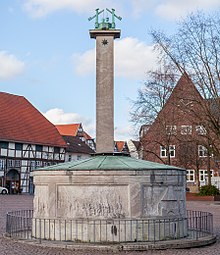Salt works bed day

The Salzwerkbettag in Bad Salzuflen in North Rhine-Westphalia looks back on over 500 years of history. The reason for its introduction was the decline in the promotion of the brine source, which is important for salt production, in the middle of the city.
history
In 1515, the brine spring on the Salzhof, which is important for the city of Salzuflen, threatened to dry up, presumably as a result of insufficient cleanliness. The spring was therefore cleaned and covered with a new floor and new wooden pipes to protect the precious spring material from renewed contamination. As a thank you for the miraculous restoration of the brine flow, a foundation was established by the city of Salzuflen with the consent of Pastor Gießenbier “with the purpose of keeping St. To have mass read, in order, through these prayers, with God's grace, to avert the complete drying up of the salt well ”. In addition, an altar loan was donated to the town church . Over time, this event became known as the “Salt Works Day”, which has been celebrated twice a year over the centuries: in mid-May and on Thanksgiving Day in October. This tradition has been preserved to this day because a small bowl of salt is remembered on the communion table of the town church on Thanksgiving and an ecumenical salt works day service takes place annually on Ascension Day at the Salzhof.
Altar loan
On May 23, 1515, the city council decided to donate an altar loan to the Catholic city church. He committed himself to building an altar and provided the necessary means (bread, wine and light). The altar priest should read or sing a mass every Thursday “in honor of God and the holy corpse”, then turn to the congregation and pray for the preservation of the brine spring . For this he was paid once a year on Michaelmas Day from the city's income. The Guild of carters joined the Foundation. The first to come was given to Mr. Christian in the mountains for life. After his death, it should be given to a citizen's son who “is a priest or becomes a priest within a year and is qualified”.
Reformation in Salzuflen
This altar loan ended with the introduction of the Lutheran creed in Salzuflen in 1531. The altar loan was rededicated to finance intercession services. The Salzwerkbettag was still celebrated: every year on May 23rd and on the harvest festival , services were held in the church on the Hallenbrink. The transition to the Reformed Confession in the 17th century went smoothly. After the saline was taken over by the Princely Rent Chamber in Detmold in 1766 , the latter also took over the payments. In 1923 the foundation was dissolved through a payment of 15,000 marks from the bathing administration to the reformed parish.
Ecumenical church service at the Salzhof
The Christian inner-city congregations have been celebrating the saltworks day on Ascension Day since 1988 as an ecumenical service on the Salzhof (the former site of the salt works near the source at that time ). The mayor also takes part as a representative of the political community. A bowl of evaporated salt on the altar indicates the occasion.
Certificate
The deed of foundation from 1515 for the establishment of the salt works bed day with the seals of the city and the church lord Antonius Gießenbier is kept in the city archive of Bad Salzuflen. In the literature there is a photo of the certificate from Meyer (page 193); A photo, the Low German wording and a translation of the certificate can be found at Linde (pages 16–19).
literature
- Franz Meyer (Hrsg.): Bad Salzuflen epochs of city history . Publishing house for regional history, Bielefeld 2007, ISBN 978-3-89534-606-4 .
- Roland Linde, Franz Meyer (ed.): Roland Linde: May 23, 1515 Establishment of the salt works bed in Salzuflen (Bad Salzufler Haus- und Stadtgeschichten booklet 10) . Home and Improvement Association Bad Salzuflen eV, Bad Salzuflen 2015, ISBN 978-3-941726-41-3 .
Individual evidence
- ↑ Stadtkirche: Salzwerkbettag accessed 2018-06-02
